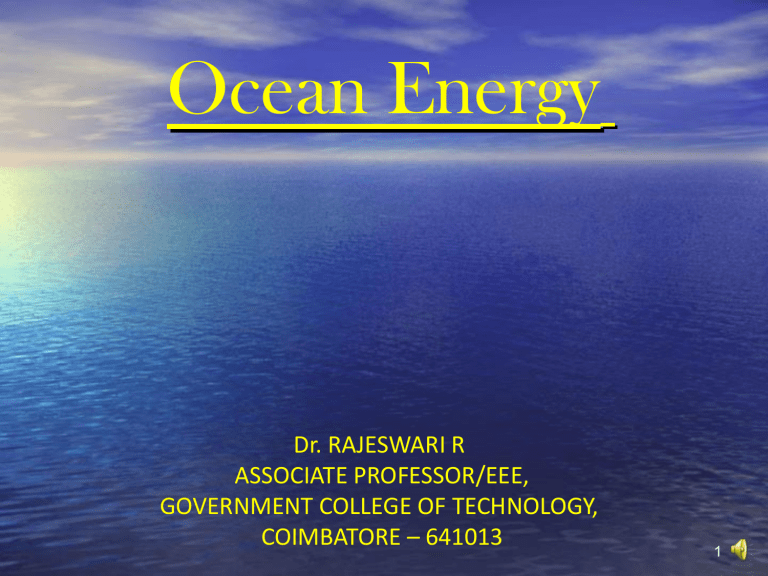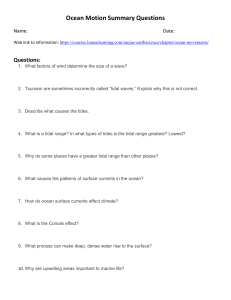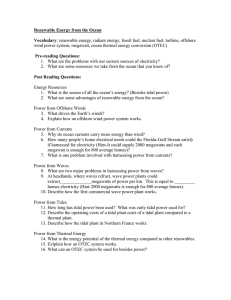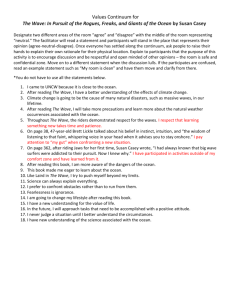
Ocean Energy Dr. RAJESWARI R ASSOCIATE PROFESSOR/EEE, GOVERNMENT COLLEGE OF TECHNOLOGY, COIMBATORE – 641013 1 Introduction • The ocean has a tremendous amount energy RENEWABLE ENERGY around the world. • Ocean energy or ocean power (or marine , hydrokinetic energy) refers to energy carried by ocean waves, tides , salinity and ocean temperature difference. • The ocean have both Wave power i.e. power from surface waves & Tidal energy i.e. kinetic energy of large moving water body. 2 GLOBAL POTENTIAL • Potential to develop 20,000 – 80,000 terawatt-hours ( TWh ) of electricity generated by changes in ocean temperatures , salt content , movements of tides , currents , waves • Indonesia is a country - three quarter of the area is ocean - 49 GW recognized potential ocean energy and has 727 GW theoreticalpotentialoceanenergy. 3 Global Potential Global potential Form Annual generation Tidal energy >300 TWh Ocean current power >800 TWh Osmotic power (Salinity gradient) 2,000 TWh Ocean thermal energy (Thermal gradient) 10,000 TWh Wave energy 8,000–80,000 TWh Source: IEA-OES, Annual Report 2007[3] 4 Different Form of Ocean Energy 1. Tidal energy 2. Ocean Thermal energy 3. Wave Energy 5 Tidal Energy • Tidal energy is the kinetic energy of large moving water body. It generate maily due to gravitational force of moon. • More predictable than wind energy and solar power. • Tidal energy can be utilized by these methods Tidal stream generators Tidal barrage 10 Tidal Stream Generator Use kinetic energy of water to driveturbine The world's first commercial-scale and grid-connected tidal stream generator – SeaGen – in Strangford Lough.[10]The strong wakeshows the power in thetidal current. 11 Tidal Energy Tidal Barrage Tidal barrage use potential energy difference between High Tide &Low tide. 12 1 2 Tidal barrage Single basin barrage Double basin systems Ocean Thermal Energy • Ocean are the largest solar energycollector. • The OTEC process uses temperature difference between deep cold water and hot surface water to generate electricity. • There are two types of OTEC plant 1.Open cycle 2.Closed cycle 13 Closed-loop OTEC • Closed cycle system use fluid with a low boiling point, such as ammonia to power a turbine to generate electricity. Open-loop OTEC cycle • The Claude Plant used an open cycle in which seawater itself plays the multiple role of heat source, working fluid, coolant, & heat sink. WAVE POWER • Solar energy from the sun creates temperature differentials that result in wind. The interaction between windand thesurfaceof watercreateswaves. Pelamis Wave Energy Converter on site at the European Marine Energy Centre (EMEC), in 2008 16 Types of wave energy technology 1)Oscillating Water Column (OWC) 2)The Pelamis 3)The Wave Dragon 4)The Archimedes Wave Swing (AWS) 5)The McCabe Wave Pump 6)The PowerBuoy 7)The AquaBuOY Schematic diagram of OWC The Pelamis The Wave Dragon Schematic diagram of the Wave Dragon The wave Dragon in operating The Archimedes Wave Swing (AWS) Schematic diagram of the AWS The AWS in operating Schematic diagram of the McCabe Wave Pump The PowerBuoy Schematic diagram of the PowerBuoy The PowerBuoy in operating The AquaBuOY Schematic diagram of the AquaBuOY The AquaBuOY in operating The positive aspects of using ocean energy are: •Reduction in the dependence on fossil fuels. •Source of energy is free, renewable and clean. •Clean electricity is produced with no production of greenhouse gas or pollution (liquid or solid). •Energy produced is free once the initial costs are recovered. •These technologies are renewable sources of energy. The negative aspects of using ocean energy are: •At present, electricity produced would cost more than electricity generated from fossil fuels at their current costs. •It leads to the displacement of wild life habitats. •Technologies are not fully developed. •Problems exist with the transport of electricity to onshore loads. REFERENCES • http://oceantidalenergy84.weebly.com/advantagesdisadv antages.html • https://www.geni.org/globalenergy/research/oceanenergy-technologies/Ocean%20Energy%20Technologies.pdf • http://oceanenergy.epri.com/ • http://www.conserve-energy- future.com/Advantages_Disadvantages_WaveEnergy.php • https://en.wikipedia.org/wiki/Marine_energy 24 Thank you 25




